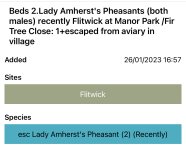
Assessing provenance has nuance. At the two extremes if I'm in the UK and see a Laughing Gull then there is a massive likelihood that it is a vagrant. Similarly if I see a Lord Derby's Parakeet then it's overwhelmingly likely to be an escaped pet. But there are are multiple cases in between. Say I see a White Stork in the UK there are 3 possibilities. It is a vagrant bird from the continental Europe, it is one of from the Knepp introduction or it is from one of the free-flying collections. I will place different probabilities on the possible origins depending on location, time of year, any rings etc. Individual birders may assign different probabilities and choose to tick an individual bird or not. In the stork case one may go with the BOU opinion that the Knepp population is not yet self-sustaining or one might differ with that opinion. If one wants to tick a stork in field next to the zoo it has just hopped over the fence from then that is an individual's perogative.
Your list, your rules is fine until you want to share or compare that list. If you are playing pitch and put with your mates you can give people do-overs not so much in the US Open.
Your list, your rules is fine until you want to share or compare that list. If you are playing pitch and put with your mates you can give people do-overs not so much in the US Open.










